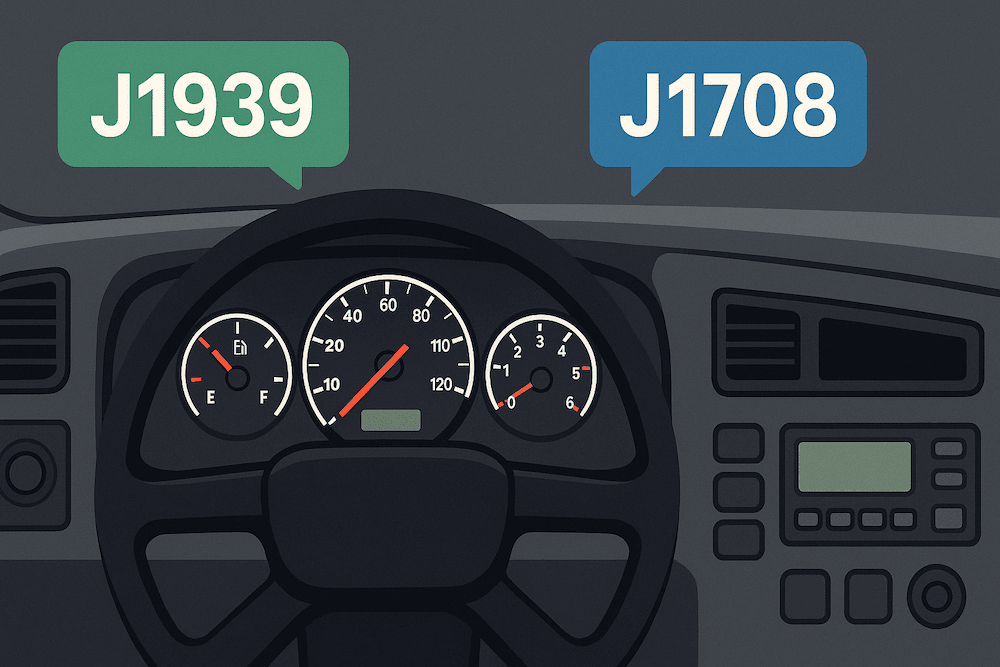Recent Posts
Bridging the Gap: J1708 to J1939 Gateways for Diesel Engine Retrofits
Posted by on
 Upgrading older diesel vehicles to support modern digital dashboards and telematics systems often requires translating legacy communication protocols. Specifically, many older heavy-duty vehicles use SAE J1708 with the J1587 data protocol, while newer systems rely on SAE J1939 over CAN bus. Bridging these two standards is essential when retrofitting dashboards, ECUs, or fleet monitoring devices.
Upgrading older diesel vehicles to support modern digital dashboards and telematics systems often requires translating legacy communication protocols. Specifically, many older heavy-duty vehicles use SAE J1708 with the J1587 data protocol, while newer systems rely on SAE J1939 over CAN bus. Bridging these two standards is essential when retrofitting dashboards, ECUs, or fleet monitoring devices.
Fortunately, several specialized J1708-to-J1939 gateways are available that can read J1587 messages and convert them into J1939-compatible outputs. These gateways enable seamless communication between older engines and new-generation instrumentation.
Why You Need a Gateway
-
J1708 uses RS-485 hardware and ASCII-based messaging (J1587).
-
J1939 uses CAN and a binary message structure with PGNs and SPNs.
-
A protocol gateway is required to translate signal formats, manage timing, and broadcast messages appropriately.
Popular J1708-to-J1939 Gateways on the Market
Here are four notable options:
1. Axiomatic AX140400 Protocol Converter
-
Bidirectional translation between J1708 and J1939
-
2 CAN ports, 1 RS-485 port
-
Highly configurable via PC software
-
IP67-rated rugged enclosure
-
Ideal for industrial and off-highway applications
2. Technoton MasterCAN V-Gate
-
Unidirectional J1708 to J1939 conversion
-
Simultaneous CAN and RS-232/Modbus outputs
-
Compact design for in-cab installs
-
Includes pre-defined PGN mapping
-
Supports telematics and dashboard upgrades
3. CA Instruments TMT-7839 Translator
-
Preloaded with common J1587 PIDs and fault code conversion
-
No configuration required – plug-and-play
-
Built-in USB for diagnostics
-
Rugged polycarbonate housing
-
Excellent for quick retrofits in trucks and marine engines
4. Au Group Electronics GW2
-
Converts 24 key J1587 PIDs to J1939 PGNs
-
Very compact, with optional waterproof variant
-
Fixed mappings, no user config needed
-
RS-232 port for monitoring
-
Affordable and reliable for basic retrofits
Key Selection Criteria
When choosing a J1708-to-J1939 converter, consider:
-
Directionality (J1708→J1939 only, or bidirectional?)
-
Configuration needs (fixed vs. user-programmable)
-
Environmental rating (IP rating, temperature range)
-
Physical size and connectors
-
Support for diagnostic data and fault codes
Each product suits different retrofit scenarios, from plug-and-play fleet upgrades to deeply integrated industrial control networks.
For more detailed information, see our post J1708-to-J1939 Gateway Solutions for Diesel Engine Retrofits (Mid-2025).
 SAE J1939 has emerged as the de facto industry standard and preferred vehicle network technology for off-highway machines, including those used in construction, material handling, and forestry. Built on the Controller Area Network (CAN) protocol, J1939 serves as a higher-layer protocol that enables serial communication between microprocessor-based systems—known as Electronic Control Units (ECUs)—in heavy-duty vehicles.
SAE J1939 has emerged as the de facto industry standard and preferred vehicle network technology for off-highway machines, including those used in construction, material handling, and forestry. Built on the Controller Area Network (CAN) protocol, J1939 serves as a higher-layer protocol that enables serial communication between microprocessor-based systems—known as Electronic Control Units (ECUs)—in heavy-duty vehicles.
These ECUs exchange a wide range of operational data, such as vehicle road speed, engine torque requests from the transmission, oil temperature, and much more, ensuring seamless coordination and efficient system performance.
The information presented in this book is primarily based on two key documents from the SAE J1939 Standards Collection:
-
SAE J1939/21 – Data Link Layer
-
SAE J1939/81 – Network Management
A Comprehensible Guide to J1939 is the first publication outside the official SAE standards to provide an in-depth yet accessible explanation of the J1939 message structure and network management. It combines technical precision with a clear, reader-friendly approach, making it an essential resource for engineers, developers, and technicians working with heavy-duty vehicle networks. More information...
 Loading... Please wait...
Loading... Please wait...
